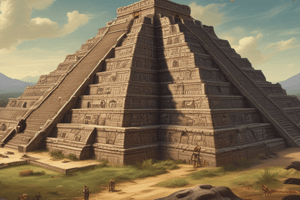Podcast
Questions and Answers
What is Lake Texcoco?
What is Lake Texcoco?
Lake Texcoco was the lake where the island on which Tenochtitlán was built is located.
What was Tenochtitlán?
What was Tenochtitlán?
Tenochtitlán was the capital city of the Aztec Empire located on a swampy island in Lake Texcoco.
What city was built on the remains of Tenochtitlán?
What city was built on the remains of Tenochtitlán?
Mexico City
What is a swamp?
What is a swamp?
What is a causeway?
What is a causeway?
What are chinampas?
What are chinampas?
Who was Moctezuma II?
Who was Moctezuma II?
What is tribute?
What is tribute?
Who was Hernán Cortés?
Who was Hernán Cortés?
What was Cortés's motive in conquering the Aztec Empire?
What was Cortés's motive in conquering the Aztec Empire?
What were conquistadors?
What were conquistadors?
What does the term 'allies' mean in the context of the Aztec Empire?
What does the term 'allies' mean in the context of the Aztec Empire?
Who was Malintzin?
Who was Malintzin?
Why were the first Europeans enchanted by the Aztecs?
Why were the first Europeans enchanted by the Aztecs?
What is an isthmus?
What is an isthmus?
What is extortion?
What is extortion?
What does the term 'Malinchista' refer to?
What does the term 'Malinchista' refer to?
Flashcards are hidden until you start studying
Study Notes
Lake Texcoco
- Located in southern Mexico, it served as the foundation for Tenochtitlán, the Aztec capital, built on a swampy island.
- Allies of the Aztecs, such as Texcoco and Tlacopan, were situated near the lake.
Tenochtitlán
- The capital of the Aztec Empire, known for its causeways connecting it to the mainland and aqueducts supplying fresh water.
- Featured bustling marketplaces where goods like gold, silver, and textiles were traded.
- Home to grand pyramid-shaped temples dedicated to various gods and innovative chinampas (floating gardens) for agriculture.
Mexico City
- Established on the ruins of Tenochtitlán, reflecting the city’s cultural and historical significance.
Swamp
- The swampy environment presented challenges for agriculture, which spurred the Aztecs to adopt innovative solutions to create a thriving city.
Causeways
- Three essential causeways constructed to link the island of Tenochtitlán to the shore, facilitating trade and movement.
Chinampas
- Created from rafts anchored to trees and covered with soil to support crop growth, effectively transforming the swamp into productive farmland.
Moctezuma II
- The last Aztec ruler whose beliefs led to the empire's decline by mistaking Hernán Cortés for a god, resulting in his eventual capture and the fall of Tenochtitlán in 1521.
Tribute
- Conquered tribes were required to pay tribute, consisting of goods like food, cotton, or gold, which significantly bolstered the Aztec economy.
Hernán Cortés
- A Spanish conquistador whose pursuit of wealth and advantage from alliances led to the Aztec Empire's defeat by 1521 through superior weaponry and strategic misunderstandings.
Motive
- Cortés's primary motivation for conquering the Aztecs was the acquisition of gold.
Conquistadors
- Spanish explorers from the late 1400s, known for their quest for wealth and the spread of Catholicism, were instrumental in the fall of the Aztec Empire.
Allies
- The Aztecs formed alliances with neighboring cities to strengthen their empire and faced betrayal from local allies of Cortés during its decline.
Malintzin
- An indigenous interpreter for Cortés, viewed as a traitor for her critical role in facilitating communication and alliances that contributed to the fall of the Aztec Empire.
European Fascination
- Early European visitors were captivated by Tenochtitlán's rich culture, impressive architecture, and the city's scale, which was five times larger than London at that time.
Isthmus
- The Isthmus of Tehuantepec, a narrow land passage connecting larger landmasses, was located within Aztec territory, situated between the Bay of Campeche and the Pacific Ocean.
Extortion
- The Aztecs engaged in extortion by threatening towns to acquire resources, such as food and precious materials.
Malinchista
- A term used in Mexico to denounce someone who betrays their own people, derived from Malintzin's collaboration with Cortés.
Rise of the Aztec Empire
- Several crucial events and circumstances contributed to the expansion and power of the Aztec Empire, shaping its historical trajectory.
Studying That Suits You
Use AI to generate personalized quizzes and flashcards to suit your learning preferences.



